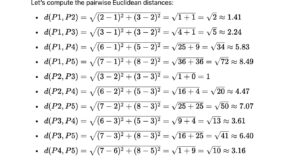Back to: Machine Learning
Hierarchical Clustering: Application, Advantages, Disadvantages, and Calculation Using Sample Data
1. Hierarchical Clustering Overview
Hierarchical clustering is a method of cluster analysis which builds a hierarchy of clusters. It is divided into two types:
- Agglomerative (Bottom-Up): Starts with each data point as its own cluster and then iteratively merges the closest clusters until all points belong to a single cluster.
- Divisive (Top-Down): Starts with all points in a single cluster and iteratively splits the most heterogeneous clusters.
The Agglomerative approach is the more common type, and we’ll focus on it in this explanation.
2. Types of Linkages in Hierarchical Clustering
In hierarchical clustering, there are different ways to measure the distance between clusters when merging them. These are called linkage methods:
- Single Linkage: The minimum distance between points in two clusters.
- Complete Linkage: The maximum distance between points in two clusters.
- Average Linkage: The average distance between all pairs of points in two clusters.
- Ward’s Linkage: Minimizes the variance within clusters.
3. Application of Hierarchical Clustering
Hierarchical clustering is widely used in various domains such as:
- Document Clustering: Grouping similar documents based on content.
- Gene Expression Analysis: Grouping similar genes based on expression patterns.
- Customer Segmentation: Identifying groups of customers with similar behaviors.
- Anomaly Detection: Identifying unusual patterns in data, especially for small datasets.
- Image Compression: Reducing image sizes by grouping similar pixel clusters.
4. Advantages of Hierarchical Clustering
- No Need to Specify the Number of Clusters: Unlike K-Means or K-Medoids, you don’t need to predefine the number of clusters.
- Dendrogram Representation: The result can be represented as a dendrogram (a tree-like diagram), providing insights into the hierarchical relationships.
- Works Well for Small Datasets: It performs well when the dataset is small to moderately large.
- Flexible Distance Measures: It can use different distance metrics and linkage methods, making it versatile for different types of data.
5. Disadvantages of Hierarchical Clustering
- Computationally Expensive: Hierarchical clustering has a higher time complexity (O(n3)O(n^3)) compared to K-Means, making it less scalable for large datasets.
- Not Suitable for Large Datasets: Due to its time complexity, hierarchical clustering may be slow for very large datasets.
- Sensitive to Noise and Outliers: Hierarchical clustering can be sensitive to noise and outliers.
- Difficult to Interpret with Large Number of Clusters: The resulting dendrogram can be difficult to interpret if there are too many clusters.
6. Hierarchical Clustering Calculation Using Sample Data
Let’s use a simple example to explain hierarchical clustering. Consider the following dataset of 5 points:
| Point | Feature 1 | Feature 2 |
|---|---|---|
| P1 | 1 | 2 |
| P2 | 2 | 3 |
| P3 | 3 | 3 |
| P4 | 6 | 5 |
| P5 | 7 | 8 |
Step 1: Compute the Distance Matrix
First, calculate the pairwise distances between all points using the Euclidean distance formula:

Step 2: Perform Agglomerative Clustering
- Start with each point as a separate cluster:
- Initially: [P1],[P2],[P3],[P4],[P5]
- Find the two closest points and merge them:
- The closest points are P2 and P3 (distance =1= 1).
- New clusters: [P1],[P2,P3],[P4],[P5]
- Find the next closest points:
- The closest clusters are [P1] and [P2,P3](distance ≈1.41).
- New clusters: [P1,P2,P3],[P4],[P5]
- Find the next closest points:
- The closest clusters are [P4]and [P1,P2,P3](distance ≈3.61).
- New clusters: [P1,P2,P3,P4],[P5]
- Finally, merge the last two clusters:
- The closest clusters are [P1,P2,P3,P4] and [P5] (distance ≈3.16).
- New clusters: [P1,P2,P3,P4,P5]
Step 3: Visualize the Dendrogram
The result of hierarchical clustering can be visualized as a dendrogram (a tree-like diagram), which shows the hierarchical relationship of the clusters.
7. Conclusion
Hierarchical clustering is a powerful and flexible method for clustering data, especially when you don’t know the number of clusters in advance. It works well for small to medium-sized datasets and provides a clear hierarchical structure. However, it can be computationally expensive for larger datasets, and the results may be sensitive to noise or outliers. Understanding the linkage methods and the distance metrics is crucial for effectively using hierarchical clustering in different applications.